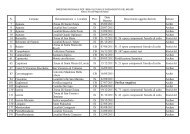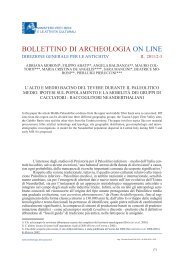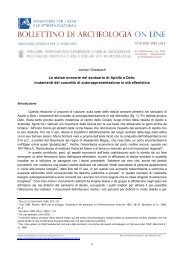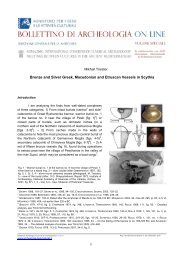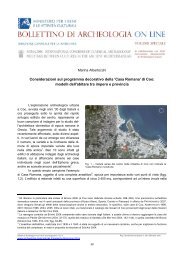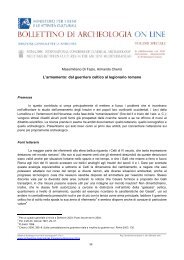Late Hellenistic Settlements in Hawrān (Southern Syria). Survival of ...
Late Hellenistic Settlements in Hawrān (Southern Syria). Survival of ...
Late Hellenistic Settlements in Hawrān (Southern Syria). Survival of ...
Create successful ePaper yourself
Turn your PDF publications into a flip-book with our unique Google optimized e-Paper software.
J. Rohmer - <strong>Late</strong> <strong>Hellenistic</strong> <strong>Settlements</strong> <strong>in</strong> Hawrân (<strong>Southern</strong> <strong>Syria</strong>). <strong>Survival</strong> <strong>of</strong> Proto-historic Urbanism and Village Architecture <strong>in</strong> a Hellenized<br />
Context<br />
ground for neighbour<strong>in</strong>g local powers, such as the Jewish Hasmonean State, the Nabataean k<strong>in</strong>gdom, and<br />
the Ituraean pr<strong>in</strong>cipality 1 . The southern part <strong>of</strong> the region, around the city <strong>of</strong> Bosra, was annexed by the<br />
Nabataean k<strong>in</strong>gdom <strong>in</strong> the late 2 nd or early 1 st c. BC. After the Roman conquest <strong>in</strong> 64 BC, Rome entrusted<br />
local client states with the task <strong>of</strong> ensur<strong>in</strong>g the stability <strong>of</strong> the northern part <strong>of</strong> the region, which had become<br />
a nest <strong>of</strong> bandits 2 . While the South rema<strong>in</strong>ed under Nabataean rule, the northern part was handed over to<br />
Herod <strong>in</strong> 20 BC. Hawrân rema<strong>in</strong>ed under Herodian and Nabataean rule throughout the 1 st c. AD, until it was<br />
eventually annexed by Rome at the turn <strong>of</strong> the 1 st and 2 nd c. AD 3 .<br />
Until recently, very few archaeological traces<br />
<strong>of</strong> this violent history had been found <strong>in</strong> the field. The<br />
first travellers and scholars essentially focused their<br />
attention on the rich Roman and Byzant<strong>in</strong>e rema<strong>in</strong>s <strong>of</strong><br />
the region 4 . However, fieldwork conducted s<strong>in</strong>ce 1974<br />
by the French Archaeological Expedition <strong>in</strong> <strong>Southern</strong><br />
<strong>Syria</strong> has generated new <strong>in</strong>formation on settlement<br />
patterns and on the material culture <strong>of</strong> these local<br />
“dark ages”. Most notably, a survey <strong>of</strong> the northern<br />
Jebel al-‘Arab and <strong>of</strong> the Leja plateau, as well as<br />
several excavations on key sites, have led to the<br />
discovery <strong>of</strong> several <strong>Late</strong> <strong>Hellenistic</strong> and “preprov<strong>in</strong>cial”<br />
settlements <strong>of</strong> significant importance (fig.<br />
1) 5 . On the basis <strong>of</strong> these results, my goal here is to<br />
address the morphological characteristics <strong>of</strong> these<br />
settlements, which attest to the survival <strong>of</strong> protohistoric<br />
traditions throughout the <strong>Hellenistic</strong> and “preprov<strong>in</strong>cial”<br />
periods, and which stand <strong>in</strong> stark contrast<br />
with the previous examples <strong>of</strong> urban genesis analysed<br />
dur<strong>in</strong>g this session. Indeed, these sites on the fr<strong>in</strong>ge <strong>of</strong><br />
the arid zone draw our attention to settlement schemes<br />
which radically differ from the progressive and<br />
dispersed mode <strong>of</strong> development hypothesized for the<br />
early phases <strong>of</strong> the “desert cities” 6 .<br />
Description <strong>of</strong> the Sites<br />
The Nuqrah and Jedur<br />
Only two cities are attested <strong>in</strong> the southern plateaus <strong>of</strong> Hawrân dur<strong>in</strong>g the <strong>Hellenistic</strong> period. To the<br />
East <strong>of</strong> Nuqrah, at the foot <strong>of</strong> the Jebel al-‘Arab mounta<strong>in</strong>s, Bosra was a prom<strong>in</strong>ent urban centre <strong>in</strong> the<br />
1<br />
See KASHER 1988 for a comprehensive study <strong>of</strong> these conflicts.<br />
2<br />
Josephus, AJ, 15.342–354; Strabo, Geography, 16.2.20.<br />
3<br />
The northern part <strong>of</strong> the region, which was under Herodian rule, was annexed to the Roman prov<strong>in</strong>ce <strong>of</strong> <strong>Syria</strong> either <strong>in</strong> 92 or <strong>in</strong> 96 AD<br />
The southern part, which was occupied by the Nabataeans, became part <strong>of</strong> the prov<strong>in</strong>ce <strong>of</strong> Arabia after Trajan’s conquest <strong>in</strong> 106 AD<br />
See SARTRE 2001, 469–527.<br />
4<br />
See, among others, BRÜNNOW and DOMASZEWSKI 1905-1909 for a compilation <strong>of</strong> previous travel narratives and expedition reports;<br />
BUTLER ET AL. 1914, 1914–1941; SARTRE-FAURIAT 2004.<br />
5<br />
In <strong>Southern</strong> <strong>Syria</strong>, the term “pre-prov<strong>in</strong>cial” applies to the period stretch<strong>in</strong>g from Pompey’s conquest to the eventual annexion by Rome<br />
at the turn <strong>of</strong> the 1st and 2nd c. AD<br />
6<br />
For Petra, see for <strong>in</strong>stance DENTZER, ZAYADINE 1992; DENTZER 1999, 237-239, and the contribution <strong>of</strong> S. Schmid to this session. For<br />
Palmyra, see for <strong>in</strong>stance WILL 1983; DENTZER, SAUPIN 1996, and the contribution <strong>of</strong> M. Hamad to this session.<br />
Bollett<strong>in</strong>o di Archeologia on l<strong>in</strong>e I 2010/ Volume speciale G / G5 / 2 Reg. Tribunale Roma 05.08.2010 n. 330 ISSN 2039 - 0076<br />
www.archeologia.beniculturali.it<br />
2<br />
Fig. 2 – Bosra: aerial view <strong>of</strong> the tell (BRAEMER 2002, fig. 2).




